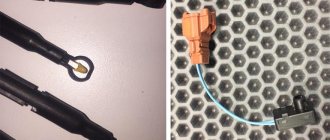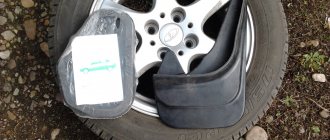AvtoVAZ management decided not to equip the Lada Vesta, which is currently the company’s flagship model, with rear mudguards. This practice is widespread throughout the world and there is nothing unusual about it. Therefore, mud flaps, like many other accessories for the Lada Vesta, will have to be purchased independently. But before shelling out money for this additional element, you should understand how necessary it is for a Russian car. In addition, you need to be careful when choosing mudguards, as they come in different qualities. This article will also provide instructions for installing these products.
The correct choice of rear mud flaps for the Lada Vesta will not only improve the appearance of the car, but will also protect it from many adverse factors. The car body will be protected from splashes of water and dirt, so the car will be able to successfully resist corrosion for many years. But in order for mud flaps to effectively protect your car, they must be correctly selected and installed.
Do you need mud flaps on the Lada Vesta SV Cross?
Mud flaps for Lada Vesta are an attribute of the passive safety of the car.
Shields are beneficial for the following reasons:
- Safety of moving vehicles from behind. Dirt, ice, stones, sand flying out from under the wheels should not interfere with other road users, since a stone hitting the windshield often ultimately leads to an accident.
- Vehicle integrity - all substances used to treat roads can get on the fenders and destroy the paint, and large crushed stones cause small dents or scratches on the underbody and body.
- Elegant appearance - cars without mud flaps always look dirty and unkempt, they have to be washed frequently, which wastes money.
Front mudguards for Vesta Cross
Traffic regulations require their presence on all wheels, so they have to be installed.
Rubber models are more resistant to wear
Rubber is an elastic material, bends easily, and does not break when passing obstacles such as storming curbs and/or city road irregularities. Rubber products are easier to clean, do not crack in severe frost, and prevent the accumulation of dirt.
Plastic models “thanks to” some personal “cons” are a little less common. The stationary surface of plastic products contributes to the accumulation of road dirt, increasing the frequency of visits to car wash complexes. At speed, plastic mudguards hold their shape and work effectively at high speeds.
The final choice is made by the owner of the car. The error is corrected effortlessly at a low cost, without leading to consequences.
Enlarged mudguards - watch the video on how to install them. Very helpful.
Why are there no rear mudguards on Vesta?
Dirt flying out from under the wheels occurs when there is an uncovered plane from the axle axis to the bottom of the body. If you remember old car models, the rear part is marked by elevation. This caused an additional need to install shields.
Modern car design, including the Lada Vesta SW Cross, tends to lower the trunk down. Thus, this part receives the necessary level of protection. Provided the roads are smooth and clear, the machine can handle debris removal without additional accessories. Therefore, AvtoVAZ supported the global trend. But in our conditions, Vesta rear mudguards are still necessary.
Do you need mud flaps for Lada Vesta?
The absence of this part on the factory version of the car negatively affects the wear resistance of the body and wheel arches of the Lada Vesta.
As practice shows, without rear mudguards, a Russian car becomes vulnerable to dirt, water, and reagents that get into unwanted places and provoke the active spread of corrosion.
At high speeds, the air flow causes a variety of different contaminants to be deposited on an unprotected vehicle. Therefore, having rear mudguards can save you from premature aging of your car.
Which mudguards to choose
To purchase mud flaps for a Vesta Sedan, you will have to make a difficult choice regarding the material from which the shield is made and the manufacturers, among which is the original from AvtoVAZ.
Made of rubber
A common option for many Lada Vesta owners are rubber guards. Some of their advantages include:
- elasticity;
- resistance to mechanical stress;
- Adhered dirt can be easily removed;
- do not provide aerodynamic resistance.
Front and rear mudguards for Lada Vesta Cross made of rubber
However, rubber also has several disadvantages:
- changes in characteristics for the worse with a decrease in air temperature;
- service life is about 1 year;
- low strength in winter.
In general, this material performs well, especially in summer.
Made from polyurethane
Plastic products for Vesta SW are relatively new on sale. They stand out with the following advantages:
- resistance to temperature changes;
- The service life of the linings is more than 1 year.
Flaws:
- rapid contamination;
- fragility, brittleness under mechanical stress.
Front and rear mudguards for Lada Vesta Cross made of polyurethane
Polyurethane is suitable for careful drivers who do not touch curbs and other high obstacles when driving.
Manufacturers
Lada Vesta of various modifications has been produced since 2015. Over the past 4 years, the number of mud flap offerings from third party manufacturers has increased. On the market you can find:
- original;
- Novline;
- Seintex;
- locker;
- AvtoDriver;
- NorPlast;
- NLF.
AvtoVAZ offers to purchase additional front (part number 99999218111382) and rear (99999218101382) guards made of chemically resistant polyurethane. They are attached with self-tapping screws, but require drilling additional holes that were not originally provided.
Unlike factory ones, Novline produces plastic linings that are attached to a latch and do not require additional drilling. There are several types varying in size. The studio separately developed mudguards for Vesta SV Cross for station wagon and sedan.
Other manufacturers followed suit. They differ in budget execution. NLF, Norplast, L.Locker linings are made from polyurethane.
Shields are made from rubber by Gard, Seintex, Autodriver. The latter are universal and suitable for all models.
Prices
After studying prices and reviews, we can conclude that many, despite the high cost, choose factory linings for 1,450 rubles. Novline are 400 rubles cheaper.
Rubber shields can be found for about 600 rubles, and larger mudguards on Vesta for 850 rubles, but they will have to be changed more often.
Installation
When you choose mud flaps in a store or on the market, remember that the average estimated cost for one set is at least 1300 - 1500 rubles.
More expensive, there is also no point in buying.
Before you begin installing this part, you will need to carry out some preparatory procedures. The first thing you need to do is remove both rear wheels from the Lada Vesta. Next, using a special brush, clean the surface of the arch from all dirt and let it dry completely.
Now that the surface of the arch is cleaned and prepared for installation, it is necessary to mark the places on it where the screws that secure the mud flaps to the body will go. To fasten this part, it is recommended to use screws measuring 4.2 mm in diameter and no more than 15 mm in length.
After the holes are made in the body, treat them with anticorrosive. Next, install the rear mudguards in their places, on the same side as the front ones. Now you can safely fasten them and check how tightly they fit.
Do-it-yourself Lada Vesta mudguard installation
Some owners order the installation of shields at a service station, but it is much faster to install mudguards on Vesta SV Cross yourself.
Required Tools
You will need the following tools and materials:
- a wheel wrench to unscrew the wheel bolts;
- jack for lifting a car;
- curly screwdriver;
- six-point screwdriver;
- drill or screwdriver;
- rag;
- metal brush;
- bitumen sealant.
Tools for installing mudguards
Litol or double-sided tape can be used as a sealant. But bitumen will be an inexpensive, quality option.
Preparatory work
Before starting installation, you need to prepare the workplace. To do this, you need to place the car on a flat surface and jack up the body. After this, unscrew the bolts securing the wheel. Remove it and place it under the bottom for safety.
Now you need to clean the area under the mudguard from adhering dirt. First, large pieces are removed with a wire brush, then the surface is wiped clean with a rag.
Front mudguards
Some configurations come with front mudguards on the Vesta from the interior, but sooner or later they must be replaced. To install the shields, you need to perform the following operations:
- Removing the old trim, if there was one.
- Marking the installation location for fasteners.
- Drilling.
- Applying a sealant to the surface.
- Shield installation.
- Removing excess dirt from the surface.
- Wheel installation.
Before your first trip, you should wait some time for the bitumen to polymerize. Therefore, it is better to carry out this work in the evening.
Rear mudguards
Installation of the shields at the rear is carried out as follows:
- After the preparatory processes, you need to attach an overlay to verify the holes already made by the factory.
- Mark the missing holes with a self-tapping screw or core.
- Use a screwdriver at low speed to drill holes.
- Remove the two existing bolts.
- Coat the trim with sealant at the point of contact with the wing.
- Attach the rear mudguards for the Vesta SV and fasten them with self-tapping screws.
- Use a rag soaked in gasoline to remove bitumen from the joints.
Installation of mudguards
After this, return the wheel to its place. When the bitumen composition has dried, the splash guards can be used.
Mudguard replacement process
Installing mud flaps will not take much time, and every motorist can handle it. Front accessories are attached to a standard location. Installing the rear ones will require a little more time and effort. In any case, the replacement procedure is described in detail in the instructions for the spare part.
Before removing the wheels, you should prepare the following tools:
- balloon for unscrewing wheels;
- crosshead screwdriver;
- brush;
- drill.
First, the wheels are placed on a jack, secured, and then removed. The place where the mudguards were attached is cleaned with a brush, and any remaining dirt is removed from it. In this case, it is important not to catch the surface of the bumper, otherwise the paintwork may be damaged.
At the next stage, the fender liner is fixed to standard holes. Self-tapping screws are used for this. Then 2 more holes are made, the diameter of which should not exceed 5 mm, not far from the standard ones, and treated with lithol. After installing the first fender liner, the second one is mounted using the same method.
If the car already has mudguards installed, the replacement procedure will not take much time, since you will not have to drill new holes. In this case, the main thing is to thoroughly clean the surface and lubricate the holes with a special compound that protects against corrosion.
Extension of front mudguards on Vesta
Standard front guards are designed for use on smooth and clean roads. When the operating area includes uneven asphalt, dirt roads or snow-covered roads, these pads are unable to protect the doors and sills of the car. Therefore, it is better to install larger front mudguards on the Lada Vesta.
Some manufacturers have taken into account these wishes of car owners and have a suitable product in their range. The price of such overlays does not exceed 1000 rubles, and the installation method does not differ from the installation of conventional ones.
In difficult road conditions, protective shields are a necessary accessory for a car. It will extend the life of the car's paintwork and save the body from premature corrosion.
conclusions
Mud flaps must be installed or regularly replaced on any vehicle. This need also affected the Lada Vesta, in which this accessory is made of polyurethane. If possible, it is better to replace them with rubber ones. The presence of such components when equipping a car will extend the service life of the body part and preserve the integrity of the paintwork. At the same time, Lada Vesta owners do not have to worry about wasting their money. They will save significantly more money on car body repairs, since it will be reliably protected from external factors.
Reviews
| № | Positive |
| 1 | Andrey (Avtodrom): the standard protection is installed, there are no special comments. True, I often slow down when crossing puddles so that there is less toss on the side members, sills, and wheel arch. |
| 2 | Sergey (Avtotema): there is not enough width to fully prevent hits. Garage mates advise installing Gard, Novline, Elegant. They are 7 cm longer, which means the likelihood of casting while driving is reduced significantly. |
| 3 | Kirill (Autoreview): the original fender liners have been installed for two years, there are no complaints, they are working on their own. |
| 4 | Alexey (Avtoria): I have plastic protection, I have to drive carefully, don’t drive at speed, and don’t get into potholes. |
| 5 | Alexander (Drom): I installed the defense on my own and completed it in half an hour. There is nothing complicated in the process. |
| 6 | Stanislav (Behind the wheel): the protection is practical, it does not deform in the cold. |
| 7 | Vasily Alekseevich (“5th wheel”): has been playing for several seasons in his native defense, and copes with his task perfectly. |
| Negative | |
| 8 | Vitaly (Avtotema): the quality of plastic for making mudguards is primitive; in cold weather from -15° the material bursts and cracks. |
| 9 | Svyatoslav (Otzovik.net): I didn’t like the standard mudguards right away, so I replaced them with new rubber ones. |
| 10 | Vlad (ProAvto): A year and a half has passed since the purchase of the car, first the left, then the right mudguard burst. |
Bottom line
So, to summarize, we can say that installing rear mudguards on a car is definitely necessary. This step will not only make life easier for other drivers, for whom stones and mud discharge from under your rear wheel will fly into the windshield, but also directly for you. After all, when installing this element, you will protect vulnerable parts of the body, namely the rear wheel arches, from corrosion and contamination. Thus, the service life of the entire vehicle will increase significantly.
Regarding the second question - what type of material to choose, it is certainly worth thinking about. When choosing a rubber option, you will receive a number of significant advantages, but also a significant disadvantage - the car will not be able to sit idle for a long time during cold weather.
Otherwise, it will be fraught with damage to the mudguards, almost instantly. In this case, your Lada Vesta should have a garage that will be able to protect it from the cold. By choosing the plastic option, you will also receive a large number of advantages. Well, the disadvantages with this choice are not significant at all. Dirt and water can be removed manually at least once a day. But regarding the fact that they break when they fall into a hole, you should understand that many other things related to the suspension also break. So, judging by this principle, then wheels are not needed. In general, the plastic option, according to many, is more advantageous.
Review of Manufacturer Prices
| Serial number/catalogue number | Price in rubles |
| AvtoVAZ Rear 99999218001382 | From 1100 |
| Novline 89108-0-147-2689 | From 1100 - 1200 |
| 89109-73-147-2689 | From 1100 - 1200 |
| Guard VS-ZBLV | From 900 |
| Avtodriver AVTMODEL2 | From 900 |
| AVTMODEL1 | From 900 |
| NLF 52.33.E10 | From 900 |
| *prices are as of May 2022 | |











